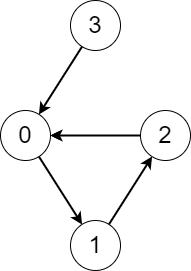LeetCode-in-Java
2876. Count Visited Nodes in a Directed Graph
Hard
There is a directed graph consisting of n nodes numbered from 0 to n - 1 and n directed edges.
You are given a 0-indexed array edges where edges[i] indicates that there is an edge from node i to node edges[i].
Consider the following process on the graph:
- You start from a node
xand keep visiting other nodes through edges until you reach a node that you have already visited before on this same process.
Return an array answer where answer[i] is the number of different nodes that you will visit if you perform the process starting from node i.
Example 1:

Input: edges = [1,2,0,0]
Output: [3,3,3,4]
Explanation: We perform the process starting from each node in the following way:
- Starting from node 0, we visit the nodes 0 -> 1 -> 2 -> 0. The number of different nodes we visit is 3.
- Starting from node 1, we visit the nodes 1 -> 2 -> 0 -> 1. The number of different nodes we visit is 3.
- Starting from node 2, we visit the nodes 2 -> 0 -> 1 -> 2. The number of different nodes we visit is 3.
- Starting from node 3, we visit the nodes 3 -> 0 -> 1 -> 2 -> 0. The number of different nodes we visit is 4.
Example 2:

Input: edges = [1,2,3,4,0]
Output: [5,5,5,5,5]
Explanation: Starting from any node we can visit every node in the graph in the process.
Constraints:
n == edges.length2 <= n <= 1050 <= edges[i] <= n - 1edges[i] != i
Solution
import java.util.List;
public class Solution {
public int[] countVisitedNodes(List<Integer> edges) {
int n = edges.size();
boolean[] visited = new boolean[n];
int[] ans = new int[n];
int[] level = new int[n];
for (int i = 0; i < n; i++) {
if (!visited[i]) {
visit(edges, 0, i, ans, visited, level);
}
}
return ans;
}
private int[] visit(
List<Integer> edges, int count, int curr, int[] ans, boolean[] visited, int[] level) {
if (ans[curr] != 0) {
return new int[] {-1, ans[curr]};
}
if (visited[curr]) {
return new int[] {level[curr], count - level[curr]};
}
level[curr] = count;
visited[curr] = true;
int[] ret = visit(edges, count + 1, edges.get(curr), ans, visited, level);
if (ret[0] == -1 || count < ret[0]) {
ret[1]++;
}
ans[curr] = ret[1];
return ret;
}
}

